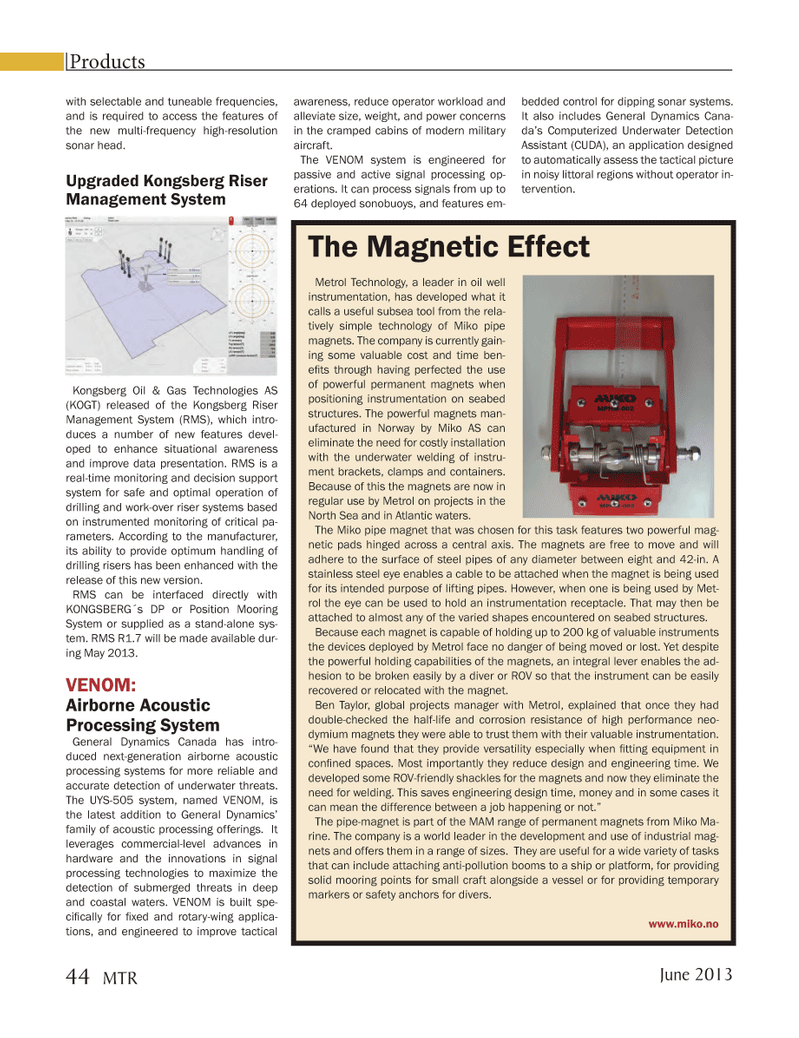
Page 44: of Marine Technology Magazine (June 2013)
AUV Operations
Read this page in Pdf, Flash or Html5 edition of June 2013 Marine Technology Magazine
Products with selectable and tuneable frequencies, and is required to access the features of the new multi-frequency high-resolution sonar head. Upgraded Kongsberg Riser Management System Kongsberg Oil & Gas Technologies AS (KOGT) released of the Kongsberg Riser Management System (RMS), which intro- duces a number of new features devel- oped to enhance situational awareness and improve data presentation. RMS is a real-time monitoring and decision support system for safe and optimal operation of drilling and work-over riser systems based on instrumented monitoring of critical pa- rameters. According to the manufacturer, its ability to provide optimum handling of drilling risers has been enhanced with the release of this new version. RMS can be interfaced directly with KONGSBERG´s DP or Position Mooring System or supplied as a stand-alone sys- tem. RMS R1.7 will be made available dur- ing May 2013. VENOM: Airborne Acoustic Processing System General Dynamics Canada has intro- duced next-generation airborne acoustic processing systems for more reliable and accurate detection of underwater threats. The UYS-505 system, named VENOM, is the latest addition to General Dynamics? family of acoustic processing offerings. It leverages commercial-level advances in hardware and the innovations in signal processing technologies to maximize the detection of submerged threats in deep and coastal waters. VENOM is built spe- ciÞ cally for Þ xed and rotary-wing applica- tions, and engineered to improve tactical awareness, reduce operator workload and alleviate size, weight, and power concerns in the cramped cabins of modern military aircraft. The VENOM system is engineered for passive and active signal processing op- erations. It can process signals from up to 64 deployed sonobuoys, and features em- bedded control for dipping sonar systems. It also includes General Dynamics Cana-da?s Computerized Underwater Detection Assistant (CUDA), an application designed to automatically assess the tactical picture in noisy littoral regions without operator in- tervention. The Magnetic Effect Metrol Technology, a leader in oil well instrumentation, has developed what it calls a useful subsea tool from the rela- tively simple technology of Miko pipe magnets. The company is currently gain- ing some valuable cost and time ben- eÞ ts through having perfected the use of powerful permanent magnets when positioning instrumentation on seabed structures. The powerful magnets man- ufactured in Norway by Miko AS can eliminate the need for costly installation with the underwater welding of instru- ment brackets, clamps and containers. Because of this the magnets are now in regular use by Metrol on projects in the North Sea and in Atlantic waters. The Miko pipe magnet that was chosen for this task features two powerful mag- netic pads hinged across a central axis. The magnets are free to move and will adhere to the surface of steel pipes of any diameter between eight and 42-in. A stainless steel eye enables a cable to be attached when the magnet is being used for its intended purpose of lifting pipes. However, when one is being used by Met- rol the eye can be used to hold an instrumentation receptacle. That may then be attached to almost any of the varied shapes encountered on seabed structures. Because each magnet is capable of holding up to 200 kg of valuable instruments the devices deployed by Metrol face no danger of being moved or lost. Yet despite the powerful holding capabilities of the magnets, an integral lever enables the ad- hesion to be broken easily by a diver or ROV so that the instrument can be easily recovered or relocated with the magnet. Ben Taylor, global projects manager with Metrol, explained that once they had double-checked the half-life and corrosion resistance of high performance neo- dymium magnets they were able to trust them with their valuable instrumentation. ?We have found that they provide versatility especially when Þ tting equipment in conÞ ned spaces. Most importantly they reduce design and engineering time. We developed some ROV-friendly shackles for the magnets and now they eliminate the need for welding. This saves engineering design time, money and in some cases it can mean the difference between a job happening or not.? The pipe-magnet is part of the MAM range of permanent magnets from Miko Ma- rine. The company is a world leader in the development and use of industrial mag- nets and offers them in a range of sizes. They are useful for a wide variety of tasks that can include attaching anti-pollution booms to a ship or platform, for providing solid mooring points for small craft alongside a vessel or for providing temporary markers or safety anchors for divers. www.miko.no June 201344 MTRMTR #5 (34-48).indd 44MTR #5 (34-48).indd 446/3/2013 1:31:46 PM6/3/2013 1:31:46 PM

 43
43

 45
45
